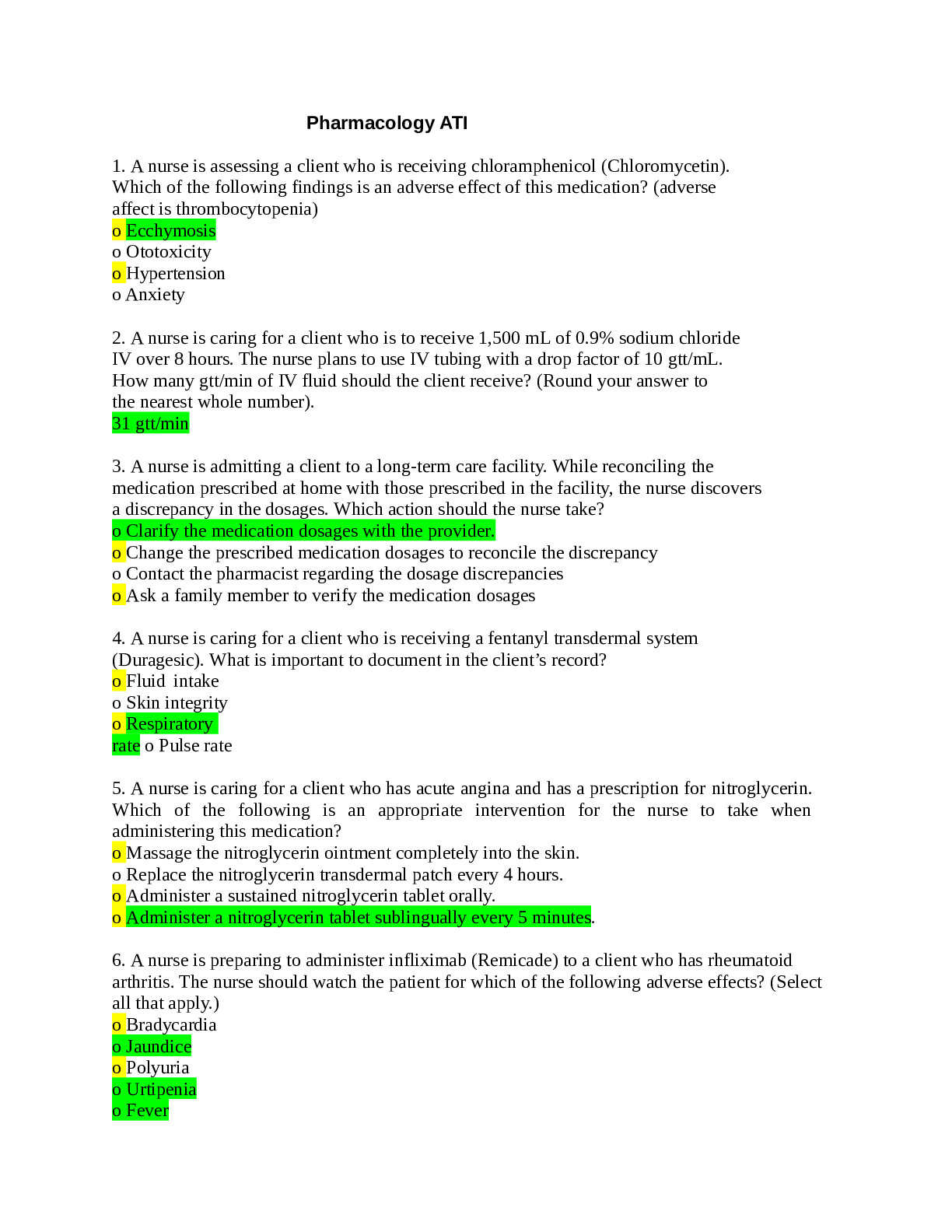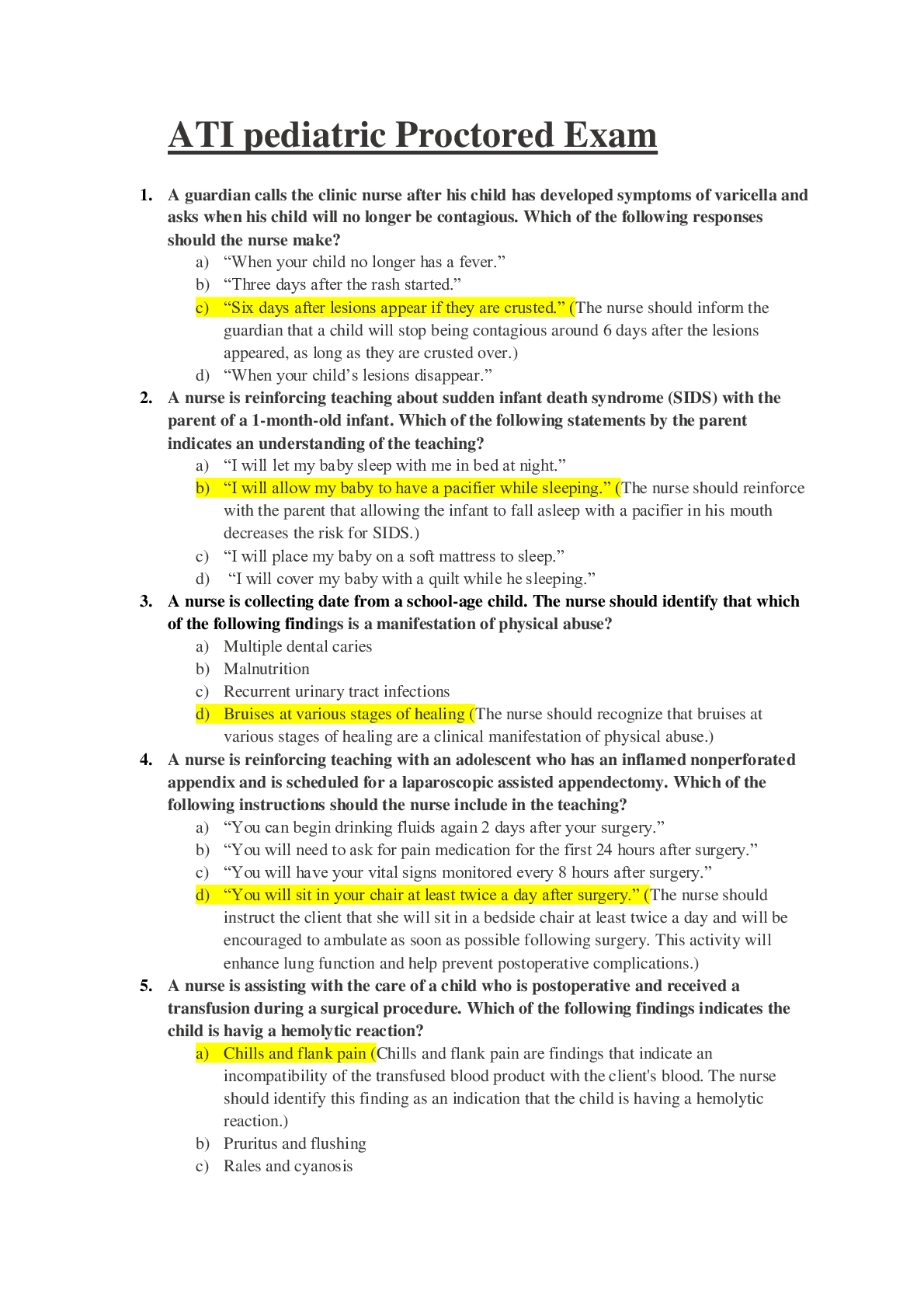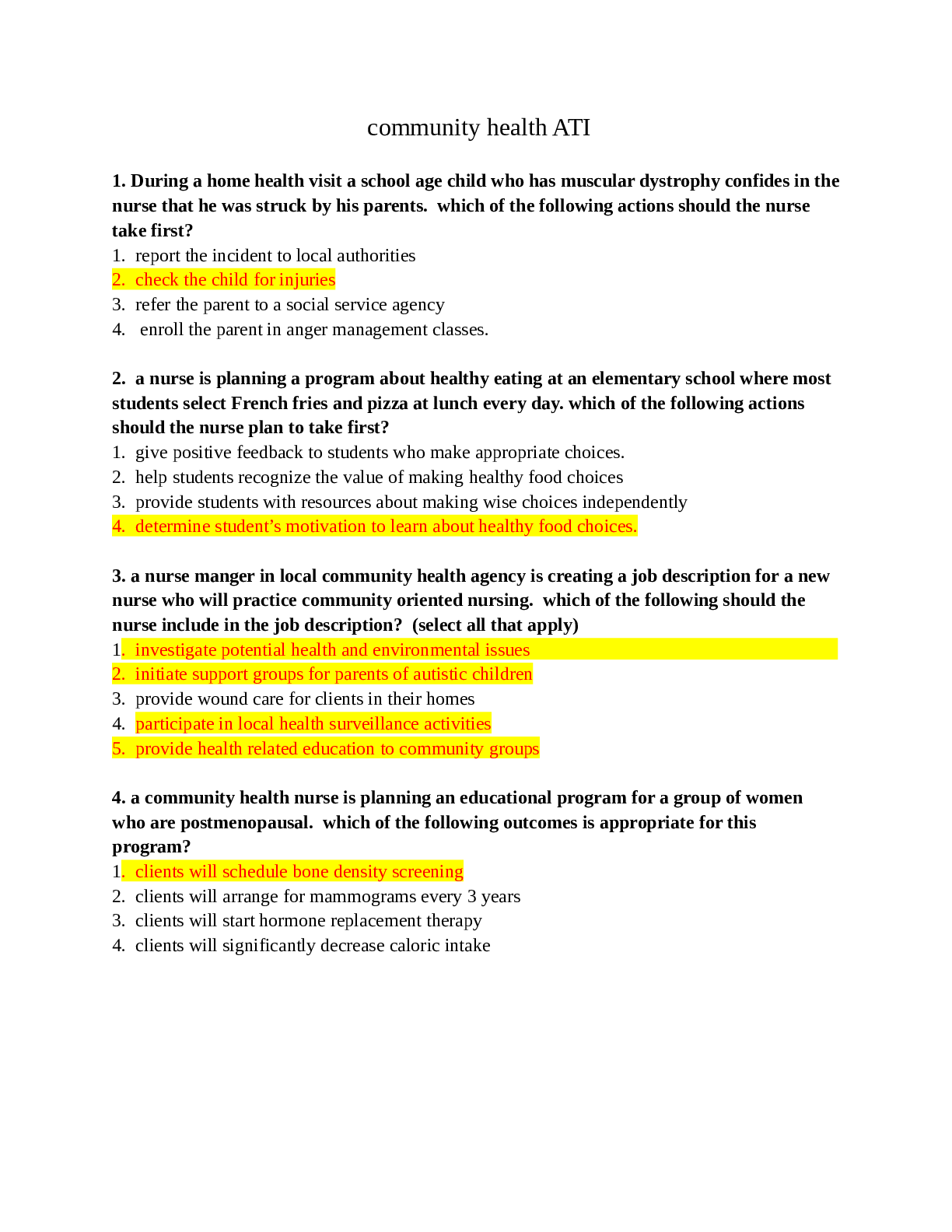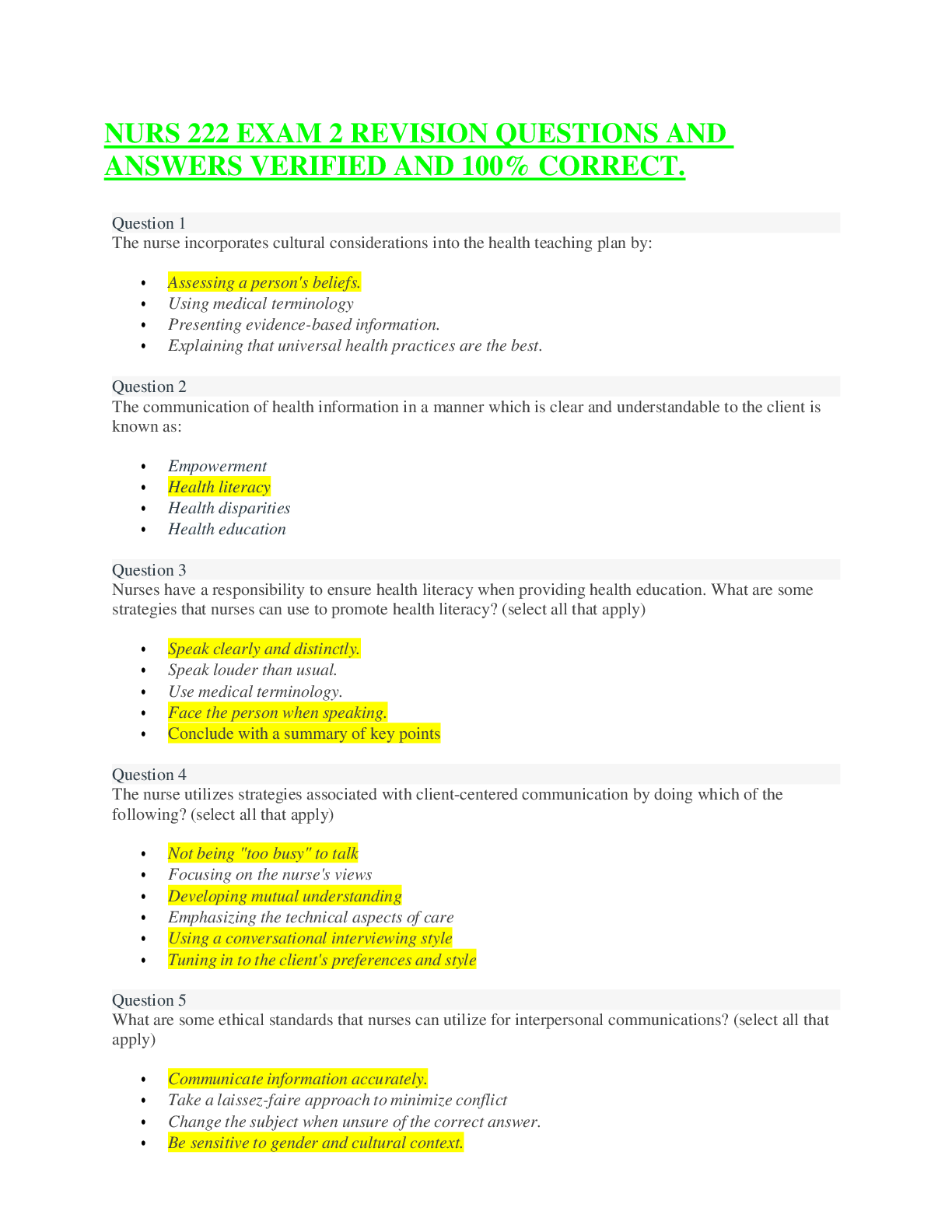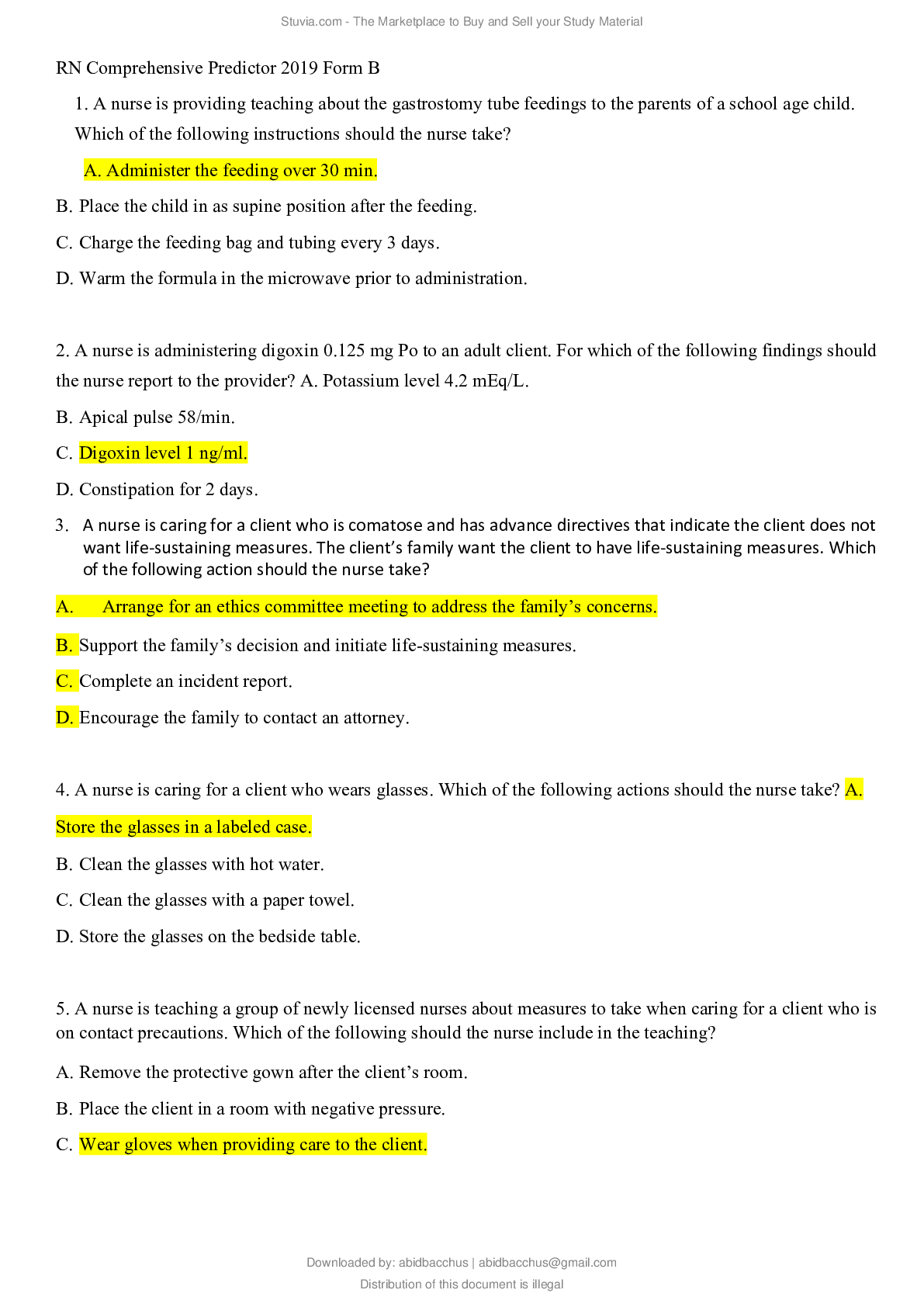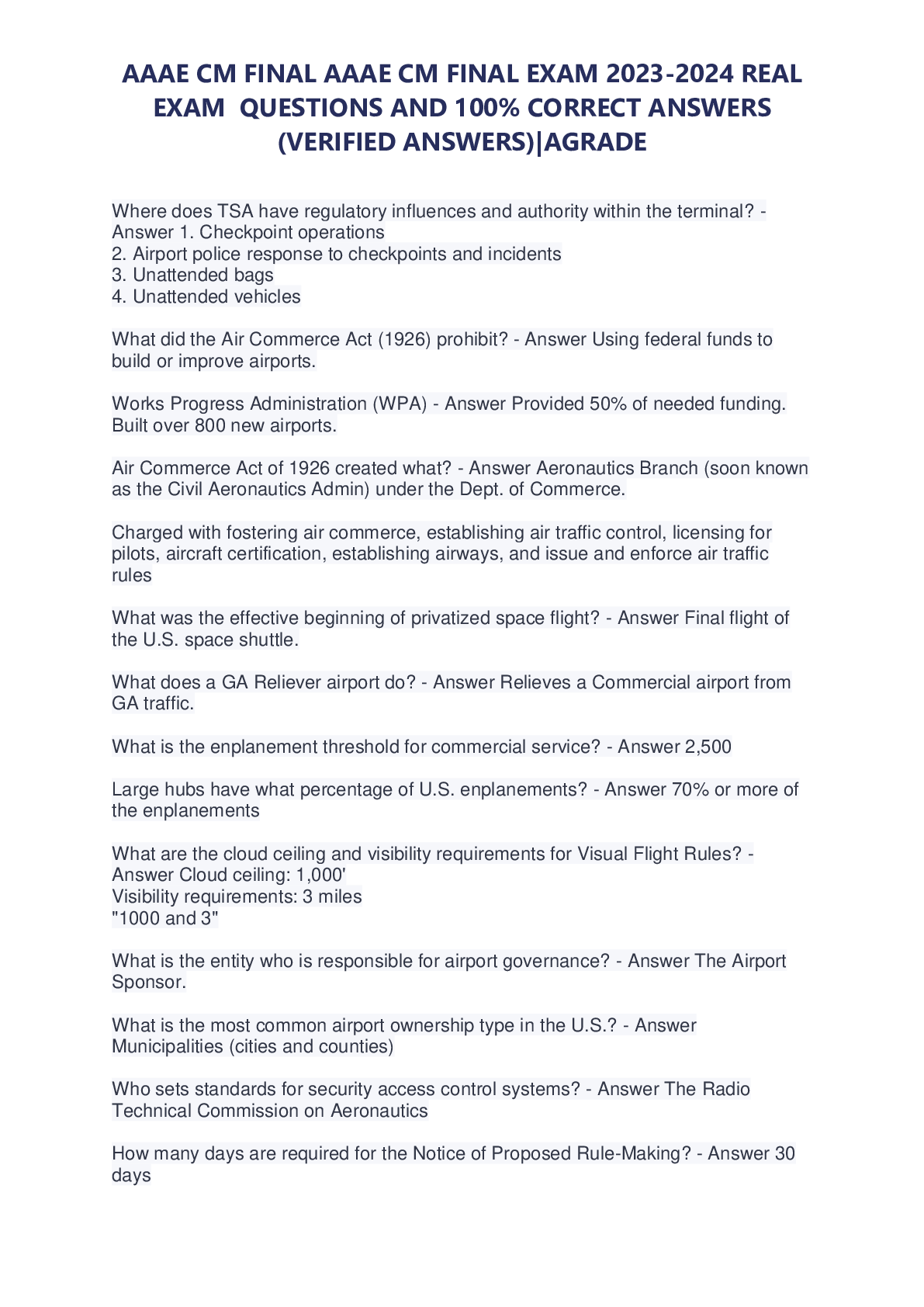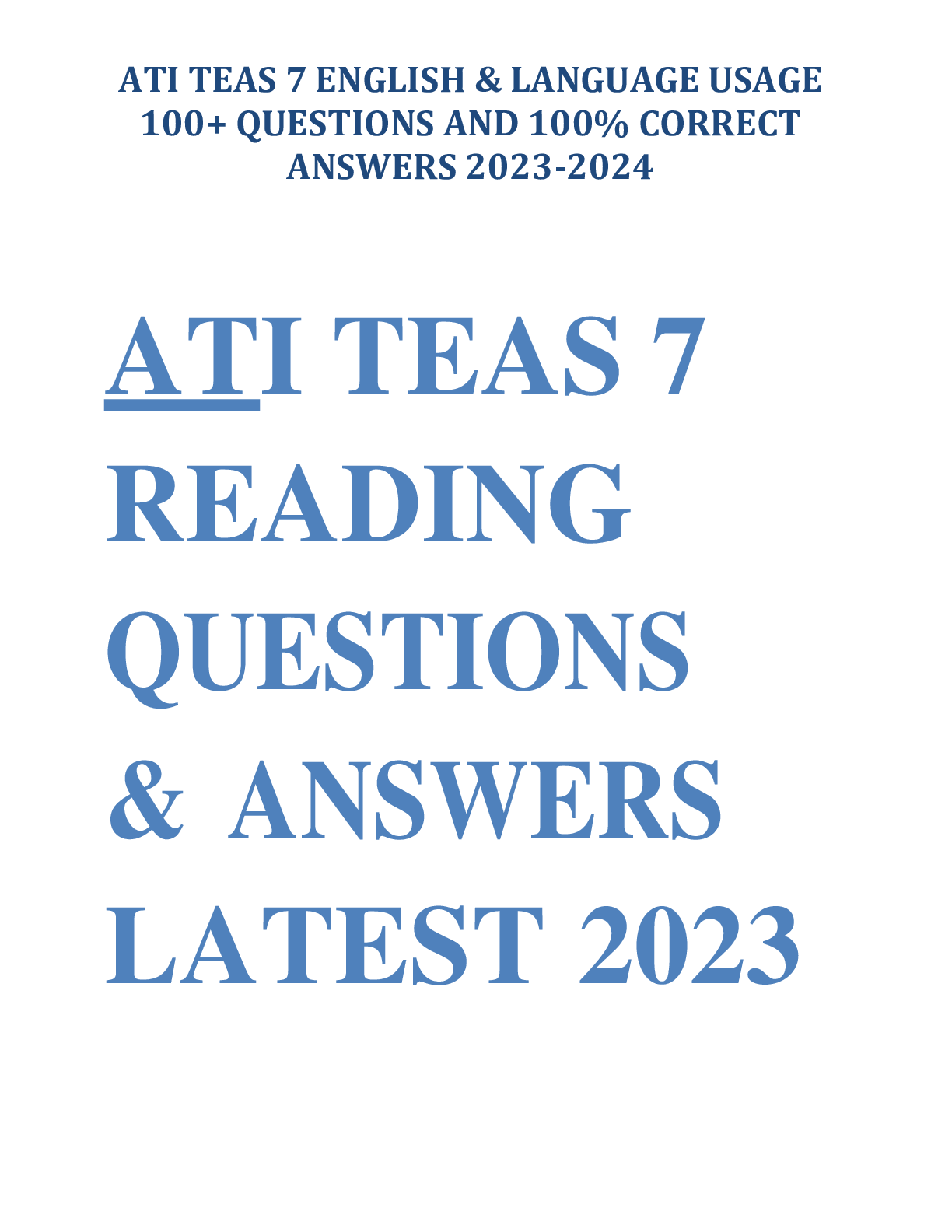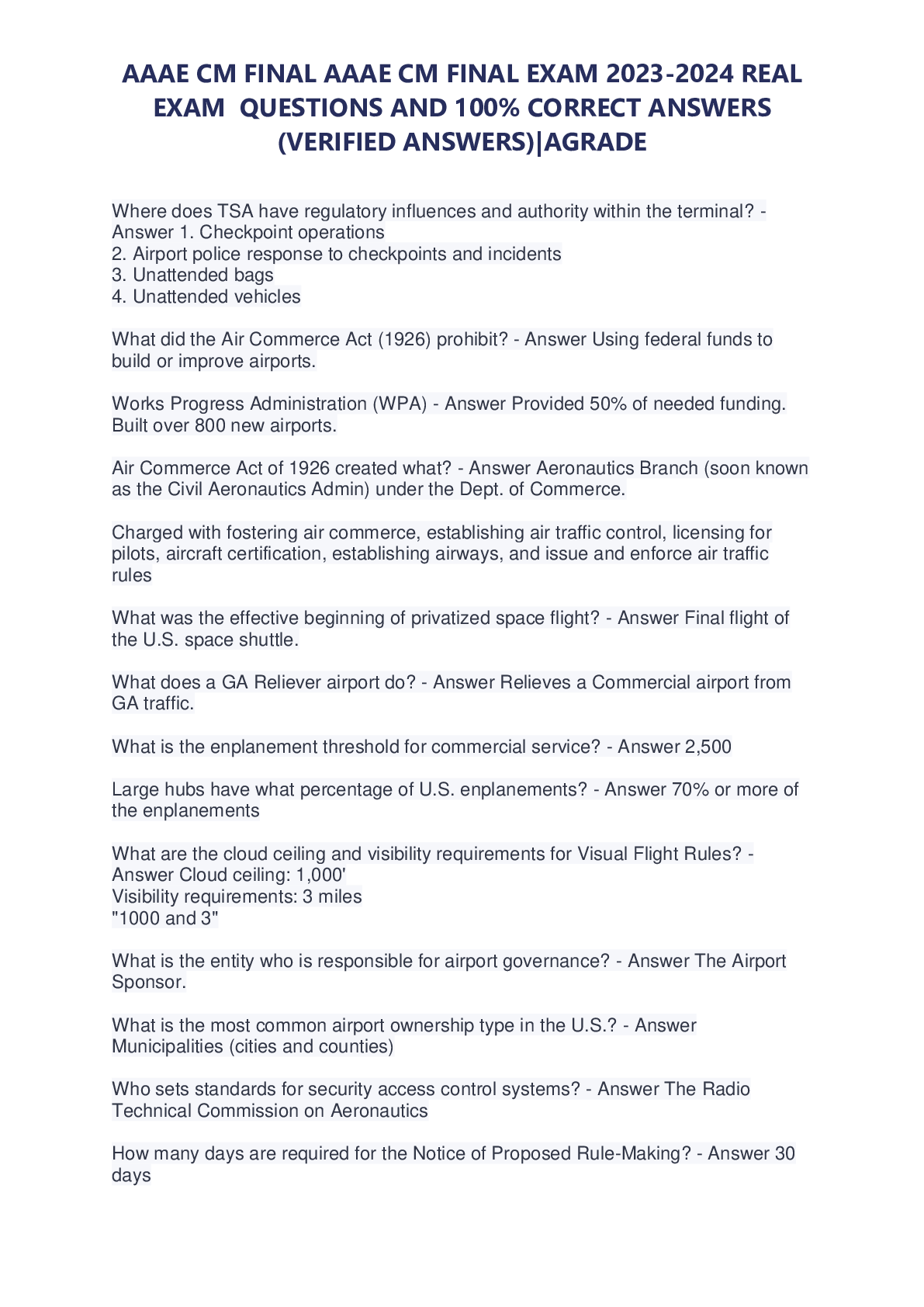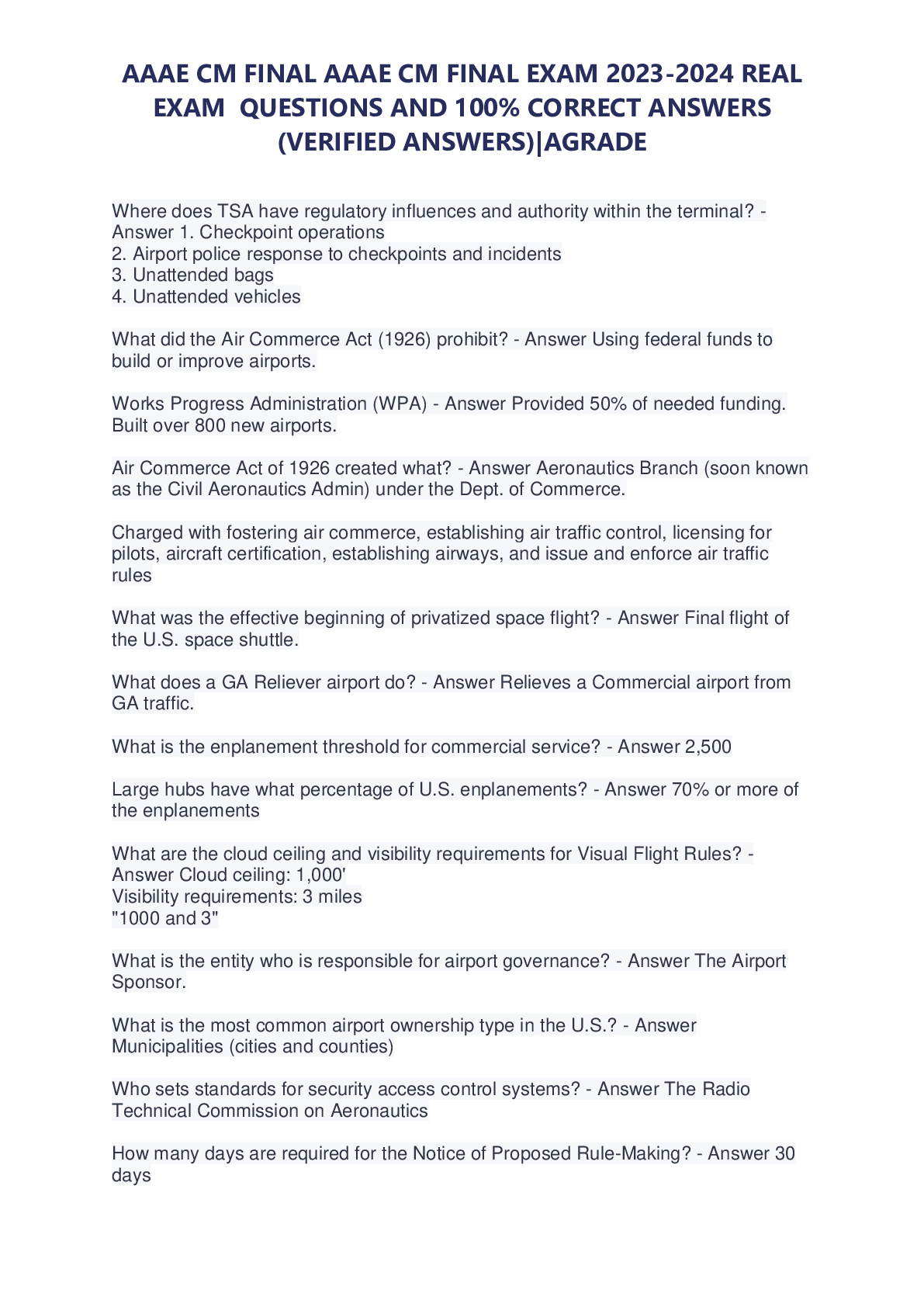*NURSING > EXAM PROCTORED > ATI PN COMPREHENSIVE Proctored EXAM-VERIFIED AND 100% CORRECT ANSWERS (All)
ATI PN COMPREHENSIVE Proctored EXAM-VERIFIED AND 100% CORRECT ANSWERS
Document Content and Description Below
ATI PN Proctored EXAM 1.what are the health care regulatory agencies joint commission state boards of nursing food and drug administration 2.what are the federally funded health care financ... es Medicare Medicaid 3.a hospital is conducting a community blood pressure screening in its lobby. what level of care is this primary the intensive care unit, oncology, treatment center and burn center are what level of care tertiary 4.immunizations and education for minimizing risk factors for illness are what level of care preventative care hospital based care in the emergency department or clinical unit are what level of care secondary 5.specialized care such as burn or cancer centers are what level of care tertiary 6.cardiac rehabilitation and home health care are what levels of care restorative 7.threatening to put a diaper on a patient if he don't use the urinal properly is considered an assault 8.a patient states he is thinking of leaving the hospital against medical advice. the nurse gave him a PRN sedative with his usual meds without him requesting it. this is considered false imprisonment 9.what would be included in a plan of care for a patient with pertussis wear a mask when providing care within 3ft of the client place a surgical mask on the client if being transported to another unit wear a gown when performing care that involves secretions 10.linear clusters of fluid-contsining vesicles with some crusting herpes zoster 11.a client reports severe sore throat, pain when swallowing and swollen lymph nodes. what stage of infection is this illness 12.what are clinical manifestations of localized versus a systemic infection fever malaise increase in pulse and respiratory rate 13.what actions should be taken to reduce risk of falls call light in reach provide nonskid footwear complete fall risk assessment 14.what are actions for a patient who has had a seizure place patient on side administer meds as prescribed be prepared to insert airway do not leave client alone during a seizure 15.what is the priority action for a client with a history of falls complete a fall risk assessment 16.what are interventions for seclusion and restraints assess restraints every 2 hours assess food, fluids, comfort, and safety and document every 15-30 mins 16.what should be included in a teaching about carbon monoxide poisoning carbon monoxide binds with hemoglobin in the body a client who has a heat stroke will have what hypotension 17.who is at risk for complications from food poisoning immunocompromised individuals 18.clients as risk for food poisoning are instructed to eat and drink what only pasteurized milk, yogurt, cheese and other dairy products 19.what bed position should the bed be in for a client receiving eternal tube feeding due to dysphagia semi-fowlers a client asks to move from the bed to the chair what is the priority action assess the clients ability to help with the transfer 20.year old with a sore throat tells doctor he has not seen the doctor since highschool. what screening should be done testicular exam 21.what should be included in health promotion and primary prevention for a school-aged child child obesity substance use disorder scoliosis stranger awareness 22.what is the first sign of maturation in boys enlargement of the testes and the scrotum 23.what are the recommended immunizations for adolescents 12-22 varicella human papilloma virus seasonal influenza 24.scoliosis is more common with who and when should screening be done girls and during adolescents growth spurts 25.what vaccines are appropriate for young adults 20-35 human papilloma virus measles, mumps, rubella varicella 26.what is an example of a middle aged adults psychosocial development expressing concern about the next generation welcome opportunities to be creative and productive become involved with community issues 27. what are expected decreases in physical function of a middle age adult metabolism gastric secretion glomerular function 28.what immunizations are recommended for a middle aged adult 35-65 varicella herpes zoster influenza 29.what should be asked for a older adult who loses weight do you eat alone or with someone have you started any new meds what have you eaten in the last 24 hour are you on a fixed income 30.what immunizations are recommended for an older adult 65 and older pneumococcal immunizations eye exam mental health screening DEXA scanning 31.what nutritional interventions are recommended for older adults increase calcium and fiber decrease sodium 32.what are expected changes in aging decreased height nail thickening decreased bladder capacity 33.a client who is on bed rest should do what to maintain latency of airways use incentive spirometer 34.what interventions should be used to reduce the risk of a dvt for a patient post-op apply elastic stockings change position frequently 35.what does a sequential compression device SCD do keeps blood pumping in legs 36.what instructions should be given to a client who is recovering from a minor musculoskeletal injury of the left lower extremities hold cane on the right side keep two points of support on the floor after advancing cane, move weaker leg forward 37.what are effects of immobility of the cardio vascular system orthostatic hypotension stasis of blood in legs increased risk of thrombus less fluid volume in circulatory system diminished autonomic response increased oxygen requirements decreased cardiac output, poor cardiac effectiveness, increased cardiac workload 38. What are the immobility effects of respiratory system? decreased respiratory movement, decreased oxygen and carbon monoxide exchange stasis of secretions and decreased and weekend respiratory muscles, atelectasis and hypostatic pneumonia 39.what strategies should be used during a physical exam use open and closed ended questions reduce environment noise perform the general surgery before the exam 40.what should be included in a general survey posture skin lesions speech 41.after inspecting the abdomen what should be done next auscultation 42.what interventions should be used of an older adult during an exam allow plenty of time for position changes make sure they have any sensory aids in place allow them to take their time answering questions allow them to use bathroom before beginning 43.a 82 year old client in ER has temp of 101, pulse 114, respiration of 22. he is restless and skin is warm.. what actions are appropriate obtain culture specimen before initiating antimicrobials encourage rest assist with oral hygiene frequently increase fluids 44.a client has a low platelet count due to chemo.. what is a priority for measuring vitals do not measure temp rectally guidelines for measuring respiratory rates place client in semi-fowlers position rest one arm over abdomen observe one full cycle before counting 45.a client has a fractured femur and a BP of 140/94 what action should be done ask if the patient is in pain what directions should be given when testing cranial nerve 5 close your mouth clench your teeth tell me when you feel a touch 46.what are expected findings when assessing the thyroid gland Palpate the thyroid in the lower half of the neck feeling the thyroid ascend when patient swallows finding symmetric extension of the trachea on both sides of the midline 46.when assessing an adult ear canal with an otoscope what actions are appropriate insert speculum slightly down and forward do not touch the ear canal with the speculum use the light to visualize the typmanic membrane on a cone shape 47.what are age related finding when examining the head and neck of an older adult tooth loss glare intolerance thickening eardrums 48.what are expected findings of an older adult during a breast exam smaller nipples more pendulous nipple inversion 49.what are expected findings when asculatating and percussing the thorax resonance tactile fremitus bronchovesicular sounds 50.an abdomen assessment shows distension, protrusion at midline, taut skin and no involvement in flanks. what is the cause of distension flatus 51.what heart sound is the left midclavicular line closure of the mitral valve closure of tricuspid valve 52.what are expected findings when auscultating and percussing the abdomen tympany borborgymi 53.what are expected findings when assessing the clients skin capillary refill in 2 seconds thick skin on soles of feet numerous light brown macules on the face 54.an older adult has tenting of the skin on his forearm. what explains this loss of adipose tissue dehydration diminished skin elasticity 55.what should the nurse examine to assess the patients peripheral vascular system who is post-op knees surgery skin color edema skin temp 56.what type of lesions are considered vesicles herpes simplex varicella 57.what findings of a skin assessment require immediate intervention cyanoisis 58.what are expected findings of a young adult male clients musculoskeletal system concave thoracic spine posteriorly concave lumbar spine posteriorly muscles slightly larger on his dominant side 59.when evaluating a clients neurosensory system, to evaluate stereognosis the nurse should ask the client to close his eyes and identify what a familiar object she places in his hand 60.what tests should be performed to test balance Romberg test heel to toe walk 61.during a Neuro exam what are expected findings with aging some vision and hearing decline slow fine finger movement some short term memory decline 62.what are actions for a patient who has had a seizure place patient on side administer meds as prescribed be prepared to insert airway do not leave client alone during a seizure 63.what is the priority action for a client with a history of falls complete a fall risk assessment 64.what are interventions for seclusion and restraints assess restraints every 2 hours assess food, fluids, comfort, and safety and document every 15-30 mins 65.what should be included in a teaching about carbon monoxide poisoning carbon monoxide binds with hemoglobin in the body 66.a client who has a heat stroke will have what hypotension 67.who is at risk for complications from food poisoning immunocompromised individuals 68.clients as risk for food poisoning are instructed to eat and drink what only pasteurized milk. yogurt, cheese and other dairy products 69.what bed position should the bed be in for a client receiving eternal tube feeding due to dysphagia semi-fowlers 70.a client asks to move from the bed to the chair what is the priority action assess the clients ability to help with the transfer 80.what interventions should be taught for a client who has multiple risk factors for cardiovascular disease help clients see benefits of their actions identify clients support system suggest community resources teach stress management strategies 90.taking courses, reading about bike safety is what kind of prevention primary 100.emergency care and surgery is what type of prevention secondary 101.rehab, learning-self management procedures, strategies are what type of prevention tertiary 102.a client previously stated her chikd is ready to potty train now states that she will post phone the toilet training.. what type of learning domain is this affective 103.expected gross motor skills of a 6 month infant rolls from back to front nears weight on legs sits unsupported 104.what should the nurse suggest regarding discipline for a toddler establish consistent boundaries 105.a toddler who says no all the time to the mother trying to help him get dressed is doing what trying to increase her independence 106.play activity of toddlers should be filling and emptying containers playing with blocks looking at books 107.activities for preschoolers should include puzzles musical toys coloring 108.what vaccines should be given at the preschool age varicella polio seasonal influenza 109.play activities for a school-aged child building models video games reading 110.what should be included in health promotion and primary prevention for a school-aged child child obesity substance use disorder scoliosis stranger awareness 111.what is the first sign of maturation in boys enlargement of the testes and the scrotum 112.what are the recommended immunizations for adolescents 12-22 varicella human papilloma virus seasonal influenza 113.scoliosis is more common with who and when should screening be done girls and during adolescents growth spurts 114.what vaccines are appropriate for young adults 20-35 human papilloma virus measles, mumps, rubella varicella 115.what is an example of a middle aged adults psychosocial development expressing concern about the next generation welcome opportunities to be creative and productive become involved with community issues 116.what are expected decreases in physical function of a middle age adult metabolism gastric secretion glomerular function 117.what immunizations are recommended for a middle aged adult 35-65 varicella herpes zoster influenza 118.what should be asked for a older adult who loses weight do you ear alone or with someone have you started any new meds what have you eaten in the last 24 hour are you on a fixed income 119.what immunizations are recommended for an older adult 65 and older pneumococcal immunizations eye exam mental health screening DEXA scanning 120.what nutritional interventions are recommended for older adults increase calcium and fiber decrease sodium what are expected changes in aging decreased height nail thickening decreased bladder capacity 121.a client who is on bed rest should do what to maintain latency of airways use incentive spirometer 122.what interventions should be used to reduce the risk of a dvt for a patient post-op apply elastic stockings change position frequently 123.what does a sequential compression device SCD do keeps blood pumping in legs 124.what instructions should be given to a client who is recovering from a minor musculoskeletal injury of the left lower extremities hold cane on the right side keep two points of support on the floor after advancing cane, move weaker leg forward 125.what are effects of immobility of the cardio vascular system orthostatic hypotension stasis of blood in legs increased risk of thrombus less fluid volume in circulatory system diminished autonomic response increased oxygen requirements decreased cardiac output, poor cardiac effectiveness, increased cardiac workload 126.what are the immomobility of respiratory system decreased respiratory movement, decreased oxygen and carbon monoxide exchange stasis of secretions and decreased and weekend respiratory muscles, atelectasis and hypostatic pneumonia 127.what strategies should be used during a physical exam use open and closed ended questions reduce environment noise perform the general surgery before the exam 128.what should be included in a general survey posture skin lesions speech 129.after inspecting the abdomen what should be done next auscultation 130.what interventions should be used of an older adult during an exam allow plenty of time for position changes make sure they have any sensory aids in place allow them to take their time answering questions allow them to use bathroom before beginning 131.a 82 year old client in ER has temp of 101, pulse 114, respiration of 22. he is restless and skin is warm.. what actions are appropriate obtain filter specimen before initiating antimicrobials encourage rest assist with oral hygiene frequently increase fluids 132.a client has a low platelet count due to chemo.. what is a priority for measuring vitals do not measure temp rectally guidelines for measuring respiratory rates place client in semi-fowlers position rest one arm over abdomen observe one full cycle before counting 133.a client has a fractured femur and a BP of 140/94 what action should be done ask if the patient is in pain 134.what are expected findings when assessing the thyroid gland Palpatine the thyroid in the lower half of the neck feeling the thyroid ascend when patient swallows finding symmetric extension of the trachea on both sides of the midline 135.when assessing an adult ear canal with an horoscope what actions are appropriate insert speculum slightly down and forward do not touch the ear canal with the speculum use the light to visualize the typmanic membrane on a cone shape 136.what are age related finding when examining the head and neck of an older adult tooth loss glare intolerance thickening eardrums 137.what are expected findings of an older adult during a breast exam smaller nipples more pendulous nipple inversion 138.what are expected findings when asculatating and percussing the thorax resonance tactile fremitus bronchovesicular sounds 139.an abdomen assessment shoes distension, protrusion at midline, taut skin and no involvement in flanks. what is the cause of distension flatus what heart sound is the left midclavicular line closure of the mitral valve closure of tricuspid valve 140.what are expected findings when auscultating and percussing the abdomen tympany borborgymi 141what are expected findings when assessing the clients skin capillary refill in 2 seconds thick skin on soles of feet numerous light brown macules on the face 142.an okder adult has tenting of the akin on hia forearm. what explains this loss of adipose tissue dehydration diminished akin elasticity 143.what should the nurse examine to assess the patients peripheral vascular system who is post-op knees surgery skin color edema skin temp 145.what type of lesions are considered vesicles herpes simplex varicella 146.what findings of a skin assessment require immediate intervention cyanoisis 147.what are expected findings of a young adult male clients musculoskeletal system concave thoracic spine posteriorly concave lumbar spine posteriorly muscles slightly larger on his dominant side 148.when evaluating a clients neurosensory system, to evaluate stereognosis the nurse should ask the client to close his eyes and identify what a familiar object she places in his hand 149.what tests should be performed to test balance Robert test 150.a helping relationship is established with a client if the communication encourages the client to express the thoughts and feelings 151.in order to facilitate effective communication with a school-age child who is seated do what sit at eye level with a child 152.what are behaviors of active listening maintaining an open posture establishing and maintaining eye contact responding positively when giving feedback 153.hat are barriers to effective communication asking personal questions offering opinions giving advice giving false reassurance minimizing feelings changing the topic asking why questions or asking for explanations offering judgments responding approvingly or disapprovingly 154.a nurse caring for a client with the same religious background should recognize that the same religious beliefs may influence individuals 155.a client scheduled for two physical therapy sessions today. what should the nurse take into consideration for the care of the Muslim client discuss the daily schedule with a client to make sure the client will have time for prayer 156.what are the five stages of grief denial anger bargaining depression acceptance 157.what should be included in teaching for a client who is diabetes mellitus about Foot Care inspect the feet daily use moisturizing lotion on the feet check shoes for any foreign objects 158.what characteristics should be included when explaining rapid eye movement REM sleep provides cognitive restoration it is difficult to awake a person vivid dreams are common 159.a client with narcolepsy should do what to help with self management take naps when feeling sleepy 160.what is an appropriate intervention for a client who is high risk for aspiration have them tuck their chin in when swallowing foods that are low in fiber and easy to digest, dairy products, eggs, custard, yogurt low residue diet 161.whole grain such as barley and oats, raw veggies, cabbage, legumes, lentils, black beans are high in fiber 162.what are nutritional needs and considerations for older adults are more prone dehydration need the same amount of vitamins and minerals as the young adults do many need calcium supplements have a slower metabolic rate, need fewer calories need more carbs and fiber reduce intake of fats and empty calories 163.characteristics of anorexia nervosa body weight less than 85% of ideal fears being fat feels fat females no menses for atleast 3 consecutive 164.characteristics for bulimia nervosa cycle of binge eating followed by purging lack of control during binges at least two binges per week for at least 3 months 165.a nurse ask a client who is come to the ER reporting severe abdominal pain whether he has nausea and vomiting. the nurse is assessing presence of Associated symptoms 166.a client is reporting pain despite analgesia. The nurse can assess the intensity of the Pain by offering the client a pain scale to measure his pain [Show More]
Last updated: 1 year ago
Preview 1 out of 22 pages
Instant download
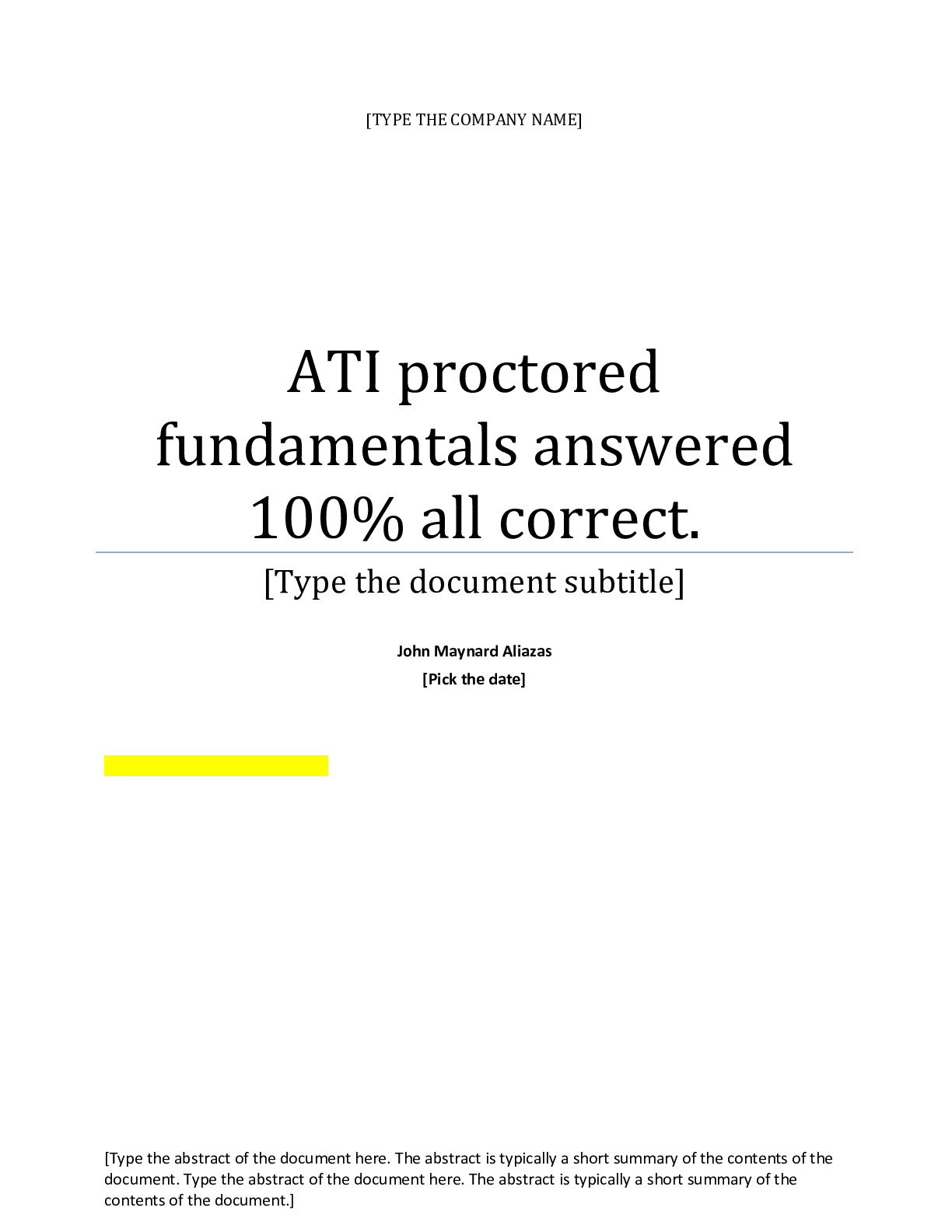
Buy this document to get the full access instantly
Instant Download Access after purchase
Add to cartInstant download
Reviews( 0 )
Document information
Connected school, study & course
About the document
Uploaded On
Sep 09, 2020
Number of pages
22
Written in
Additional information
This document has been written for:
Uploaded
Sep 09, 2020
Downloads
1
Views
154



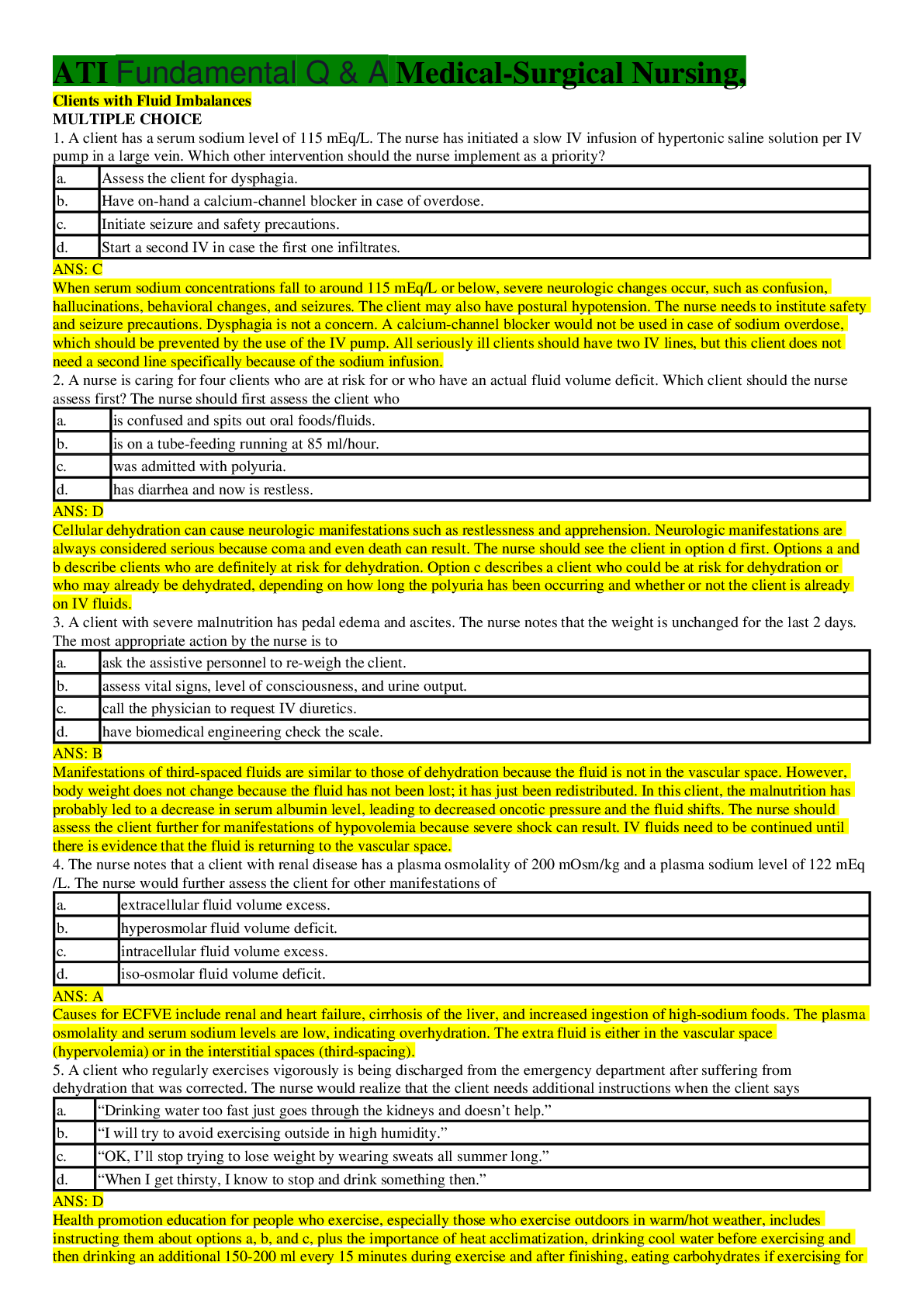
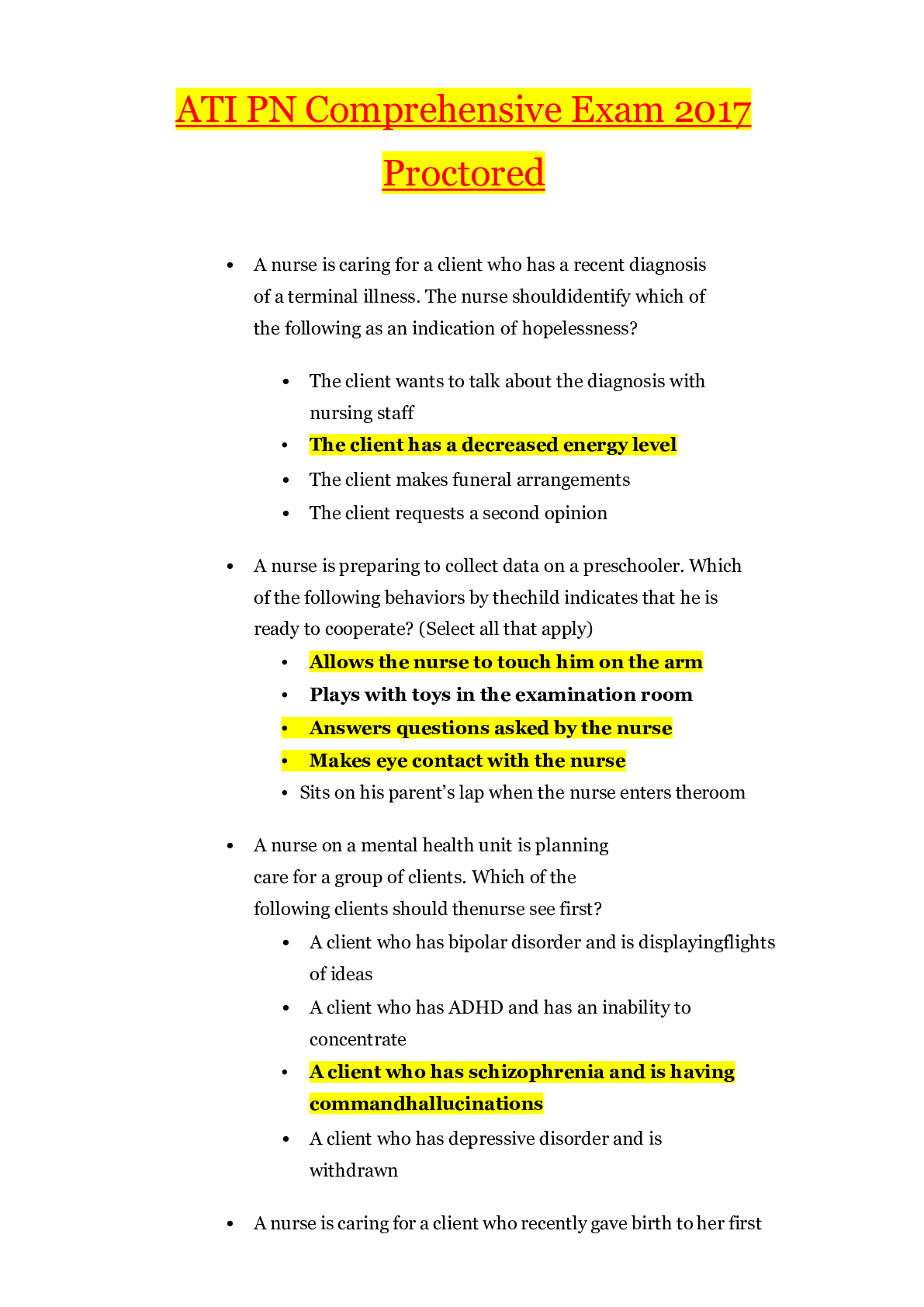
.png)
